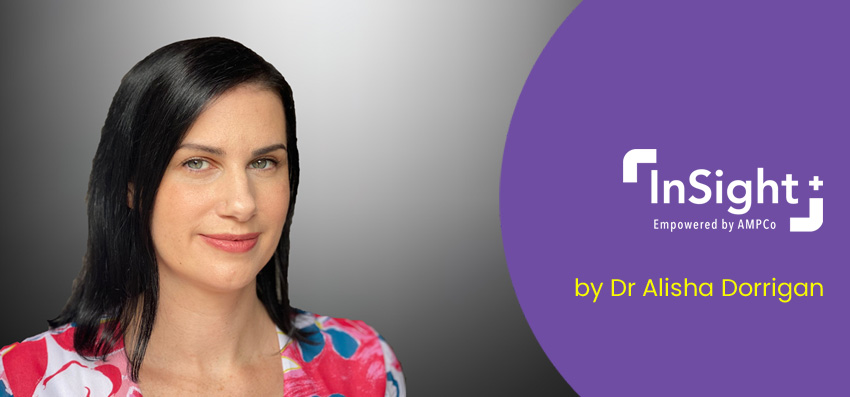In this inSight+ article Dr Alisha Dorrigan, a Sydney-based GP and Deputy Medical Editor for the Medical Journal of Australia states how it would be an incredible achievement if patients across the country were able to receive the full spectrum of reproductive health services, including medical abortion, through their own GP clinic.
‘Embedding women’s reproductive rights into primary care’
IN the wake of the downfall of Roe v Wade that left many in a state of shock, it was equally shocking to learn that the alarming ruling made by the Supreme Court didn’t send US legislation well behind that of Australia’s, but rather left both on relatively equal footing.
There is no constitutional right to access abortion in Australia, and the legal status of the medical procedure is decided by state and territory governments. The fortunate difference between the US and Australia is that most states and territories have removed abortion from their criminal code; however, the decriminalisation process has been painstakingly slow, with South Australia doing so only weeks ago.
While the events taking place in the US are a chilling reminder that there is never a time for complacency when it comes to women’s reproductive rights, it is also a time to turn outrage into action. In the flurry of discourse that has erupted in recent weeks, we have been reminded that there is still a long way to go when it comes to abortion access in Australia.
Public health systems are generally not integrated with abortion services and therefore don’t offer them – a disconnect that could potentially make it easier for state governments to further restrict access if they were motivated to do so in the way we have seen in the US.
Improving access via the public health system is a vital step for ensuring equitable abortion access for Australian women, especially those in rural and remote areas. So too is improving access through Australia’s primary care network – for GPs there is huge potential to make a real difference to abortion access.
For many women of reproductive age, GPs will not only be their first point of contact with the health system, but often their only point of contact as this is a cohort of generally healthy individuals. For women who find themselves pregnant and considering abortion, it is vital for GPs to be equipped with the tools to empower women to make the choice that is right for them and trust that they will be guided down their chosen path with professional support and accurate advice.
The most obvious answer to embedding reproductive rights within primary care is for GPs to become providers of early medication abortion or to encourage an interested GP within each clinic to do so.
The training to prescribe MS-2 Step (a combination of mifepristone and misoprostol) is freely available and can be completed online. Since its approval by the Therapeutic Goods Administration in 2014, the uptake of MS-2 Step has steadily increased over time. However, as recently as 2019, 30% of women lived in areas in which GPs did not prescribe MS-2 Step. This proportion was 50% for women living in remote areas, where access to abortion is already extremely difficult.
While we wait for training on medical abortion to be incorporated into the GP curriculum and for improved funding, with increasing resources and a gradual dispelling of myths, such as a poor safety profile or efficacy rate of early medical abortion, there has never been a better time to upskill in this area. It would be an incredible achievement if patients across the country were able to receive the full spectrum of reproductive health services, including medical abortion, through their own GP clinic.
In addition to the online training, there is a wealth of practical advice and tips on early medical abortion available through a recent webinar hosted by North Western Melbourne Primary Health Network that is now free to access. The webinar features an informative presentation by Melbourne-based GP Dr Lynda-Rose Chapeyama, who demystifies the process of providing early medical abortions in the clinic setting and shares her approach to managing early pregnancy presentations. This includes how to promote a safe space for women requiring early pregnancy ultrasound scans with well written referrals and a thorough approach to safety netting, alongside suggested strategies for pain management and other potential MS-2 Step side effects.
Medical termination, while safe and effective, will not be preferred by all women seeking abortion services and some will not be eligible, as it is only appropriate up to 9 weeks’ gestation. Knowing how and where patients can access surgical abortion is also important. Resources such as HealthPathways can be useful depending on the local area.
No discussion around abortion is complete without also considering contraception – an important aspect of clinical care for all women of reproductive age. This is a particularly important conversation to have with women considering or after having an abortion.
The use of long-acting reversible contraception (LARC) is associated with a lower likelihood of repeat early medical abortion, and some contraceptive options, namely the progestogen-only pill, seem to be associated with an increased likelihood of repeat early medical abortion. These are important considerations when advising women of their potential options for contraception.
Upskilling to insert LARCs, or knowing which colleagues to refer to for insertion, should form part of routine abortion care in general practice. It is often more convenient, quicker and with less out-of-pocket expenses for patients to see a GP for insertion rather than attend other specialty services.
Embedding the full spectrum of reproductive health care within general practice will strengthen women’s reproductive rights, alongside improving health outcomes for women and allowing them to be cared for by practitioners who they are known to and who will offer long-term follow-up.
While we can be cautiously optimistic that the National Women’s Health Strategy (2020–2030) listed “equitable access to pregnancy termination services” as a “key measure of success”, there has yet to be any meaningful action in this space, but GPs can take matters into their own hands.
While we wait, hope, advocate and campaign for improved reproductive health care, we can offer our patients comprehensive reproductive services that empower women to take control of their reproductive health and support them as they navigate abortion access across Australia.
Dr Alisha Dorrigan is a Sydney-based GP and Deputy Medical Editor for the Medical Journal of Australia.
(article and photo credit – inSight+)
Associate Professor Magdalena Simonis AM is a Past President of the AFMW (2020-2023), former President of VMWS (2013 & 2017-2020) and current AFMW National Coordinator (2024-2026). She is a full time clinician who also holds positions on several not for profit organisations, driven by her passion for bridging gaps across the health sector. She is a leading women’s health expert, keynote speaker, climate change and gender equity advocate and government advisor. Magda is member of The Australian Health Team contributing monthly articles.
Magdalena was awarded a lifetime membership of the RACGP for her contributions which include past chair of Women in General Practice, longstanding contribution to the RACGP Expert Committee Quality Care, the RACGP eHealth Expert Committee. She is regularly invited to comment on primary care research though mainstream and medical media and contributes articles on various health issues through newsGP and other publications.
Magdalena has represented the RACGP at senate enquiries and has worked on several National Health Framework reviews. She is author of the RACGP Guide on Female Genital Cosmetic Surgery and co-reviewer of the RACGP Red Book Women’s Health Chapter, and reviewer of the RACGP White book
Both an RACGP examiner and University examiner, she undertakes general practice research and is a GP Educator with the Safer Families Centre of Research Excellence, which develops education tools to assist the primary care sector identify, respond to and manage family violence . Roles outside of RACGP include the Strategy and Policy Committee for Breast Cancer Network Australia, Board Director of the Melbourne University Teaching Health Clinics and the elected GP representative to the AMA Federal Council. In 2022. she was award the AMA (Vic) Patrick Pritzwald-Steggman Award 2022, which celebrates a doctor who has made an exceptional contribution to the wellbeing of their colleagues and the community and was listed as Women’s Agenda 2022 finalist for Emerging Leader in Health.
Magdalena has presented at the United Nations as part of the Australian Assembly and was appointed the Australian representative to the World Health Organisation, World Assembly on COVID 19, by the Medical Women’s International Association (MWIA) in 2021. In 2023, A/Professor Simonis was included on the King’s COVID-19 Champion’s list and was also awarded a Member (AM) in the General Division for significant service to medicine through a range of roles and to women’s health.

